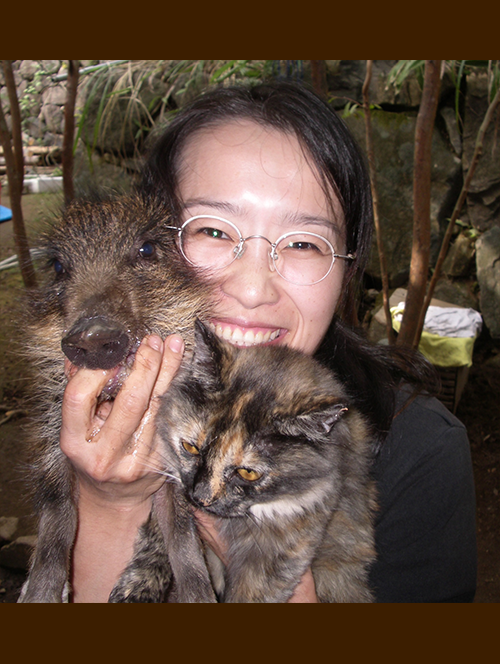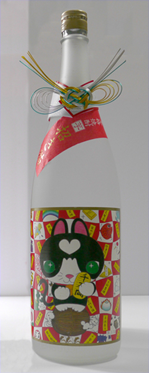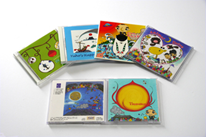Tamzo's Message
There are those who cannot go to the places they want to go due to illness. There are those who cannot do something they want to do even though they are healthy.
I will be happy if many people enjoy my drawings and become more cheerful. It encourages me and gives me energy to do drawings.
I wish to draw illustrated books and illustrated maps of places all over the world. I wish to make drawings of the Mandala (Buddhist tapestries depicting the enlightened mind and the cheerful and compassionate Buddha) in the future.
I wish to see people smiling throughout the world. These are the reasons why I draw these pictures.
I wish to protect all wild animals living in nature. I wish to protect the important places of the Buddha from which flows the lives of the animals and plants. This is my dream.
Koyasan
Series
Koyasan Series "O-daishi-sama"
This is a drawing of Kobo Daishi and the myriad people and animals who adore him dearly.The models for these characters are those who live around me and whom I know very well.
Kukai, now known as Kobo Daishi, took part in a government-sponsored expedition to China in the early 9th century, where he studied esoteric Buddhism and learned all there was to know in only two years. He then returned to Japan where he founded the Shingon (True Word) sect of Esoteric Buddhism.
The Seven Gods
of Fortune Series
The Seven Gods of Fortune Series"Treasure Ship"
The Treasure Ship is a sailboat that carries the Seven Gods of Fortune (commonly referred to in English as the Seven Lucky Gods) and their treasure. It is considered to be a lucky charm and it is said that you will have a good Hatsuyume (the first dream of the year) by putting a picture of the Treasure Ship under your pillow on New Year's night.
The Seven Gods
of Fortune Series
The Seven Gods of Fortune Series "Ebisu-sama"
Ebisu-sama is the god of fishing. Fishermen imagine that there are only fish and themselves in the universe whenever they are fishing (that is what I think).
Ebisu-sama is one of the Seven Gods of Fortune. He is often depicted wearing a tall hat and Kariginu (hunting costume) while holding a rod in the right hand and a red sea bream in the left. Ebisu-sama was originally considered the god of fishery, as the red sea bream symbolizes, but now has become revered as the god of business prosperity.
Birds
Series
" Japanese Pheasant
and Copper Pheasant "
Birds Series " Japanese Pheasant and Copper Pheasant "
I often meet with them in the mountain where I live. There should be such a scene.
Pheasant are native to the Japanese Archipelago. It is said that the female Japanese Pheasant has a strong maternal instinct as many people have witnessed that she will protect her eggs at the risk of her life. The Japanese Pheasant is the national bird of Japan and often appears in Japanese folklore. Children are well acquainted with it. The Copper Pheasant was once a candidate for the national bird of Japan but lost out to the Japanese Pheasant. Since they have long tails, the Copper Pheasant often appears in Japanese poetry as a symbol of longevity.
Ibu
Series
" Ibu (a wild boar) and
Japanese pampas grass "
Ibu Series " Ibu (a wild boar) and Japanese pampas grass "
Special story
 Her drawings are influenced by the feel of the changing seasons in the middle of the great nature that encompasses the mountain. Tamzo also loves animals and believes that relationships with animals are important for a meaningful life. Among the many animals that have come and gone, there is a special memory of Ibu, the wild boar piglet. Ibu was a newly born wild boar piglet that was discovered lying in a ditch next to a mountain trail several years ago, completely helpless and unable to move. Although she realized the difficulties in taking care of such a wild animal, Tamzo was determined to nurse this small, weak piglet to good health. One sad day, sorrow struck when Ibu suddenly took ill and departed this life. For Tamzo, it was like losing her
own child. Despite the unexpected sorrow of Ibu's untimely departure, Tamzo keeps the memory of Ibu alive in her mind and in her work. For Tamzo, every living thing on earth, regardless if an animal or a plant, is an object of affection. Tamzo's drawings reflect the purity of her respect for all living things. In 2006, The Tamzo Calendar was dedicated to Ibu. It was produced in loving memory of Tamzo's prized companion. The illustrations in the Ibu calendar are characterized by deliberate lines expressing Ibu's various characteristics season by season over the time they were together. Ibu lives on in those drawings, created with the purity of a mother's love for her newborn baby spilling out from Tamzo. Because of her compassion for all living things, Tamzo is loved by children and animals alike, even infants who cannot yet express themselves through words. Animals, children and Tamzo have a special connection that facilities understanding and attracts them to each other. Tamzo's personal magnetism stems from a purity of mind that is permeated by love. Tamzo's drawings reflect the light that emanates from her personal magnetism.
Her drawings are influenced by the feel of the changing seasons in the middle of the great nature that encompasses the mountain. Tamzo also loves animals and believes that relationships with animals are important for a meaningful life. Among the many animals that have come and gone, there is a special memory of Ibu, the wild boar piglet. Ibu was a newly born wild boar piglet that was discovered lying in a ditch next to a mountain trail several years ago, completely helpless and unable to move. Although she realized the difficulties in taking care of such a wild animal, Tamzo was determined to nurse this small, weak piglet to good health. One sad day, sorrow struck when Ibu suddenly took ill and departed this life. For Tamzo, it was like losing her
own child. Despite the unexpected sorrow of Ibu's untimely departure, Tamzo keeps the memory of Ibu alive in her mind and in her work. For Tamzo, every living thing on earth, regardless if an animal or a plant, is an object of affection. Tamzo's drawings reflect the purity of her respect for all living things. In 2006, The Tamzo Calendar was dedicated to Ibu. It was produced in loving memory of Tamzo's prized companion. The illustrations in the Ibu calendar are characterized by deliberate lines expressing Ibu's various characteristics season by season over the time they were together. Ibu lives on in those drawings, created with the purity of a mother's love for her newborn baby spilling out from Tamzo. Because of her compassion for all living things, Tamzo is loved by children and animals alike, even infants who cannot yet express themselves through words. Animals, children and Tamzo have a special connection that facilities understanding and attracts them to each other. Tamzo's personal magnetism stems from a purity of mind that is permeated by love. Tamzo's drawings reflect the light that emanates from her personal magnetism.
Other Series
"Inch Aeons"
"Inch Aeons"
Tamzo creates worlds inside worlds. Her medium allows for shades of depth and allusion. Compositionally, she mirrors and twists meanings so what seems at first calming creeps into something more disconcerting. A child's balloon is made and moves by air, as does a hot-air balloon, as does a sail.And then there is the darkness of the precipice and the jagged danger of the rocks below. (Proud! Precipice Blessed!) A stream streams in the shape of clouds surrounded by creatures, cartoonish and real. And the creatures have halos and the horizon slips away.(Chingokuji's kids) A dragon slithers through a mountain range to a modern village below but on each of the passed peaks is a world of time past; a village without satellite antennas and signs, a village in flames, and a village of woodland animals without human strain. (In that grainy Lapse) Tamzo's illustrations are of the best sort: finely illustrating both the seen and unseen.
Teresa Carmody, Las Figues Press
Tamzo's Works
| 1995-2013 | ||
| 1995 | ·“ Kanmuri-dake Mairi “ leaflet, the first art-work |  |
| 1998 | ·“ Illustrated map of Minami-odawara, Koya mountain “ for Hamada-ya Co., Ltd. |
|
| 2000 | ·CD jacket “ Neo KAGOMAGO “, “ Animal Drive “ |  |
| ·Design work of paper bag for Kagoshima Prefectural Government Office |
 |
|
| 2001 | ·“Design work of O-Daishi-sama ( Great Teacher Kohbo ) calendar “ | |
| ·An illustration on Docomo telephone card for NTT DOCOMO, INC. |
||
| ·“ Shichifuku Jin ( The Seven Gods of Fortune ) calendar “ | ||
| ·CD jacket “ Yuho’s Happy Songs “ | ||
| ·CD jacket “ Kagoshima-ben no Mojoka-uta “ | ||
| 2004 | ·“ Tori ( The Birds ) calendar “ | |
| ·Art-works for Nuala Archer’s poetry book “ Inch Aeons “ published by Les Figues Press of Los Angeles. |
||
| ·“ Ibu ( a wild boar ) calendar “ | ||
| 2008 | ·“ Inochi ( Life ) “ ( the first art-work by Japanese painting materials on Japanese paper ) |
|
| ·“ Tamzo “ ( a label on Shochu bottle for Iwagawa Jozo Co., Ltd. ) |
||
| 2011 | ·“ Maneki-Neko” ( a label on Shochu bottle for Hombo Shuzo Co., Ltd. ) |
|
Birth of the Illustrator Tamzo
Tamzo was born in Kamakura-city, Kanagawa Prefecture, Japan and later graduated high school in 1990. During the spring holidays just before entering college, she visited a temple in Kagoshima for the first time with her relatives. The small temple in the mountain, named Yoe-an, was a foothold for the members working to reconstruct Chingoku-ji, a Buddhist temple of the Shingon Esoteric sect, which had been destroyed in the early years of the Meiji era (approximately 140 years ago) as a result of a movement to abolish Buddhism by Imperial loyalists. As a typical 18-year-old youth of that time, she denied neither Buddhism nor the traditional Shinto gods of Japan and made the occasional customary visits to family tombs and to Shinto shrines on New Year. However on her first visit to this temple, she felt something special when she first met the high priest of the temple, commonly referred to in Japan as Osho-san (honorable high priest). She spent several days with the people of the temple community, all of whom had come from various places, but the temple community had the feeling of a big family. They lived together with Osho-san and had a strong determination to reconstruct the temple Chingoku-ji. Included among the temple family were many animals that were more than mere animals but friends and members of the community as well. She had never experienced such a joyful time and those days consequently had a lasting impact on her life. She subsequently entered college and worked hard day after day in her studies. However, she become frustrated over time as she began to feel that the days were simply passing away without meaning or purpose. At the age of 20, only one year away from graduation, she visited the temple Yoe-an again with a desire to change herself. That was the beginning of her life at the temple. She learned many things including traditional Japanese culture, human relationships, formal Japanese manners, cooking, and many other things while in the midst of the busy daily work schedule that included the physical labor of the reconstruction of Chingoku-ji, kitchen duties, laundry duties, and taking care of the animals. The experiences of temple life become her foundation. She never compromises. She faces every matter wholeheartedly. Her temple foundation shows in her art. She may redraw one line hundreds of times, making changes of no greater than one millimeter until she becomes completely satisfied. She also became interested in the healing principles of acupuncture as a result of her life at the temple and went on to become an acupuncturist out of a desire to help others through that traditional healing art. She entered Kagoshima Acupuncture School in 1993, the oldest acupuncture school in Japan. She graduated in 1996 and obtained a license as a practitioner of acupuncture, moxibustion and massage. Following the start of her career in acupuncture, the turning point toward art came to her suddenly. One day Osho-san glanced at a letter she was writing to a friend that included some cute illustrations and he noticed the drawings right away. He was so impressed by the illustrations that he told her she should become a professional illustrator. Osho-san then gave her the name Tamzo, meaning treasure chest from which many dreams flow out endlessly. Thus, Tamzo the Illustrator was born. She immediately began the self-study of paintings and today, with her wholeheartedness, natural artistic sense and deep insight, Tamzo displays her talent and offers her dreams to all who view them.
Tamzo's Activities
In 1996, at the age of 24, Tamzo joined AOB & Davinci International Co., Ltd., which had recently moved to nearby Kagoshima City following the disastrous Hanshin-Awaji earthquake that devastated the city of Kobe and surrounding areas.
She created illustrations for music CD jackets, illustrated maps, corporate logos, and other business related illustrations. Her work is always characterized by thorough preparation and a unique perspective on the subject.
As an example, there is a drawing of an Israeli woman who lives at the temple and who has rather large buttocks.
Anyone can easily notice at a glance and with smile who the woman in the drawing is. The woman who is the subject of the drawing finds it to be a delightful illustration.
Tamzo captures and illustrates the best in a subject in a unique way, and this characteristic is common in all of her works. Several years after becoming a professional illustrator, she engaged in the production of a calendar at the request of the company.
In the first Tamzo Calendar, she drew many of the sacred places of Kohya mountain, the location of the headquarters of Shingon Esoteric Buddhism, along with illustrations of Kobo Daishi, its founder, in whom many Japanese continue to put their faith today.
The Tamzo Calendar is revised and put on sale each year.
Newer versions of the calendar feature illustrations she titled, "The Seven Deities of Good Fortune," and "The Birds."
Many of the illustrations featured in the calendar are also sold on Tamzo Postcards.
The Tamzo Tojikomeru postcard features her illustrations adorned with real local or regional artifacts such as volcanic ash from Mt. Sakurajima in Kagoshima City, cedar chips from the forests of Yakushima Island and black sand from the Ibusuki hot springs area.
All are created to reveal the nature of the Kagoshima area.
In the modern era of email and other forms of digital communication, letter writing is rapidly falling by the wayside.
It is Tamzo's wish that children will discover the unique joys and emotional appeal of letter writing and postcards through her illustrated works on Tojikomeru postcards used as educational materials in schools.
Tamzo receives notoriety not only in Japan but overseas as well, having made her American debut in 2006. Nuala M.
Archer, an Associate Professor at Cleveland State University at that time, saw Tamzo's drawings and requested permission to include them in her book of poetry, "Inch Aeons," published by Les Figues Press of Los Angeles.
Tamzo provided exotic drawings in black and white for this unexpected encounter with Nuala. Teresa Carmody, editor in chief, commented that, "Tamzo's illustrations are of the best sort: finely illustrating both the seen and unseen."
In 2003, Tamzo held her first exhibition
and in five days it drew more than 1,000 visitors. Some of the comments from some of the visitors were: "I feel the warmth coming from every illustration," ( Female, 16 ) "I felt inspired by her works," ( Male, 44 ) "I find a complete story in each of her illustrations," ( Female, 25 ) "They are full of dreams.
I feel at ease," ( Male, 71 ) Tamzo is currently learning traditional Japanese-style painting by self-study and recently finished drawing, "A
Ruddy Kingfisher," one of her most recent illustrations with an outstanding sense of color. She is also expanding her world of art by taking part in the website design for the local Happy Brienden concert group as well as doing make-up artistry for the group's members.
Tamzo's drawing style
Tamzo is entirely a self-taught artist, drawing on her natural talents. She uses pens to draw the lines. For coloring, she usually uses colored pencils on Kent paper. More recently, she has also been working on larger scale paintings using traditional painting materials such as pigment, glue, gold leaf and Japanese paper.
heart3
Exhibitions
Tamzo Exhibition in Israel
- Exhivition 1: Tikotin Museum of Japanese Art
-
The Tikotin Museum of Japanese Art is located in Haifa, the largest port city in Israel. It is famous for its collection of valuable Japanese art and houses the largest collection outside of Japan. The museum was founded in 1959 and possesses 7,000 items of Japanese art, 4,000 of which were donated after World War II by Mr. Felix Tikotin, a Jewish art dealer.
-
The gallery walls are specially painted for each exhibition to provide the best backdrop for the art. After critical review by their art experts, the Tamzo Exhibition was scheduled for display at the museum from July12 to December 27, 2014.
- Opening: Saturday, 12 July 2014, 8:00 pm
- Gallery Talk: Friday, 18 July 2014, 10:00 am -12:30 pm
- Closing: Saturday, 27 December 2014
- Cuator: Dr.Ilana Singer Blaine
- Address: 89 Hanassi Ave., Haifa, 34529, Israel. View map
- Phone: 04-8383554
- Exhibition 2: The 39th International Arts and Crafts Festival Jerusalem
This massive arts festival draws 60,000 -100,000 people every year and will be held this year between August 12 to August 23, 2014, in Jerusalem, Israel. A maximum of two artists from each of 40 nations are invited to the festival to exhibit their artwork. Tamzo was invited as this year’s only representative artist from Japan.
- Opening: 11 August 2014
- Closing: 23 August 2014
- Hours: 18:00-23:00 on weekdays,
20:00-24:00 on Saturday
Closed on Friday - Location: Hutzot Hayotzeir
Contact : kohybt@gmail.com
 Let's have a good time at Tamzo World
Let's have a good time at Tamzo World
Testimonial
Since first being exposed to Tamzo's fine and subtle paintings, I've been enchanted by the way in which, using thin, delicate lines, she creates distant worlds, sometimes - how symbolic - enclosed within a teardrop.
Observing one of her works which attracted me initially through its ornamental side, I felt how the colorful reality of the painting -with its human beings and supernatural creatures -gradually became fraught with mysticism, sweeping me away from the plain visual realm, to a more metaphysical one. In my eyes, Tamzo is a uniquely gifted artist, who succeeds in giving a vibrant picturesque life to the thoughtful ideas that inspire her.
I welcome the opportunity of exhibiting her paintings full of wonder, to the Israeli public.
Yitzhak Lior
Former Ambassador
to Japan
One . December
2013
Contact
All Rights Reserved AOB & DAVINCI INTERNATIONAL
AOB & DAVINCI INTERNATIONAL CO., LTD.
Akebono-cho 84,
Ichikikushikino-shi,
Kagoshima-ken
896-0001
Japan
T +81-996-33-0615
F +81-996-33-0614
toiawase@aob-davinci.com
